There’s an undeniable charm to a yard filled with overarching trees, trellises smothered in flowering vines, and elegant evergreen shrubs.
Given the choice, most of us would opt for a yard with mature trees and bushes over a bare plot of land.
But when we go to fill up our herb gardens, many of us discover that having a lush plot comes with its own set of challenges.
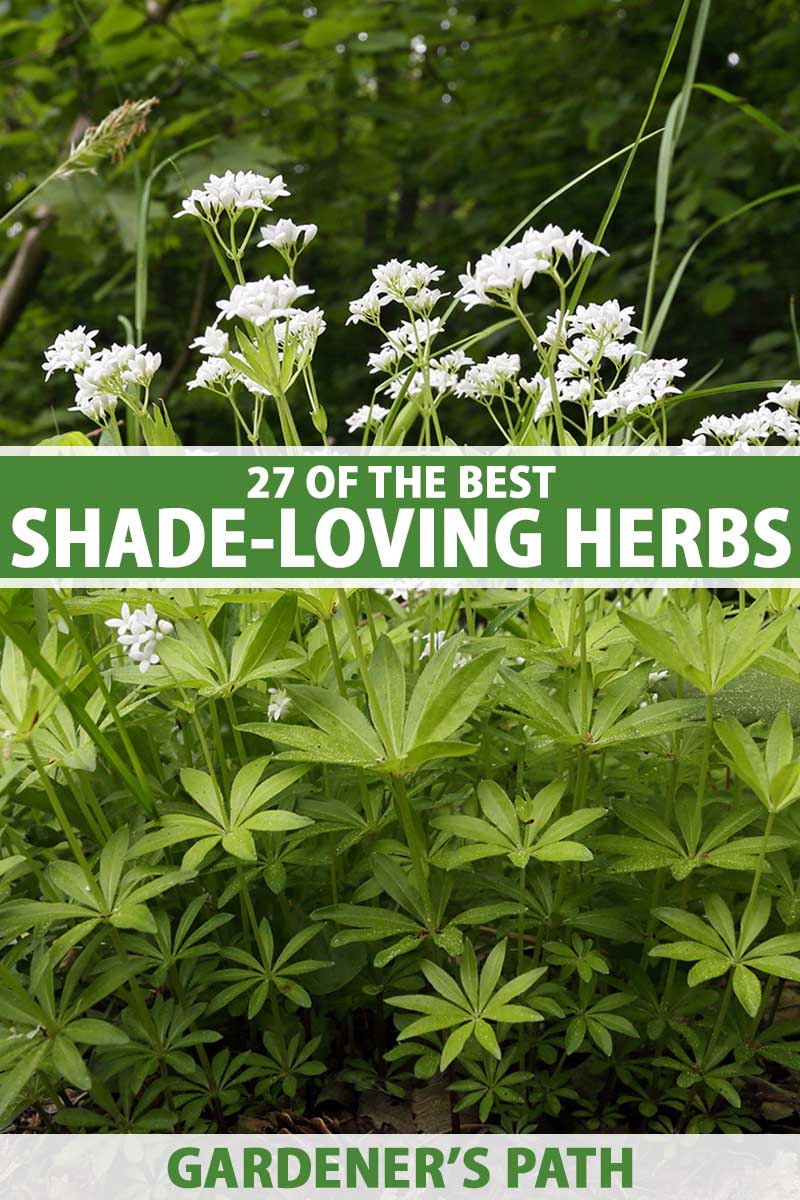
We link to vendors to help you find relevant products. If you buy from one of our links, we may earn a commission.
If you don’t have a ton of full exposure spots left in your yard but you can’t get enough homegrown herbs, then you know the pain.
Or maybe you just want to fill a shaded spot with something other than the usual hostas, ivy, and ferns. Though, don’t forget, hostas and some ferns are edible, so… No shade on these plants.
Whatever your challenge, up ahead, we’re going to go over some common and not-so-common herbs that will produce even if they don’t sit in a sunny spot.
Here are the species we’re going to look at:
27 of the Best Herbs for Shade
Not every herb on this list thrives in shade. Some plants will simply tolerate it. But all of them will produce so you can enjoy the fruits of your labor without the sunburn.
1. Agrimony
Some species in the Agrimonia genus need full or partial sun, but there are a few species that thrive in partial or full shade.
A. gryposepala, also known as tall hairy agrimony, and A. striata, or roadside agrimony, both thrive in partial or full shade in USDA Hardiness Zones 6 to 9.
All of the herbs in this genus are entirely edible from root to tip, with varying taste appeal.
Some are best used solely for tea and others are downright delicious. For more palatable species, baking the stems, flowers, and leaves creates a tasty meal.
Otherwise, use agrimony sparingly in soups and salads or for medicinal purposes.
You can find packets of 10 seeds available at Earthbeat Seeds.
2. Angelica
Generally, experts recommend growing angelica – Angelica species, primarily A. archangelica – in partial sun, but it will thrive in partial or even full shade so long as you don’t overwater.
Those dramatic flower heads will be smaller or non-existent in full shade, meaning fewer seeds, which are the most commonly used parts of the plant.
But if you’re open to using the stems, leaves, and roots rather than the seeds and flowers, you can grow these herbs in shady spots where most herbs falter.
Angelica is fairly tolerant of a range of conditions, and not just when it comes to light. It’s hardy in Zones 4 to 9 and can handle a range of soils.
If you’re stumped about how to use up your harvest, read our guide to harvesting and using angelica.
You can snag a live plant at Burpee or a packet of 50 seeds from Earthbeat Seeds.
Check out our guide to growing angelica for more information.
3. Black Cohosh
Black cohosh (Actaea racemosa), also known as black baneberry, is valued as a medicinal plant.
It’s one of those species that grows in the forest understory, so it’s fine with lower light. It can also grow well in soggy soil or drier ground, making it a versatile option.
Hardy in Zones 3 to 8, this beautiful plant has elegant spires of flowers followed by striking berries.
Not just an ornamental, it’s a popular medicinal plant as well. Don’t eat it, though – it’s toxic in large doses.
You can pick up packets of 50 seeds from Earthbeat Seeds.
Learn more about baneberry and how to grow it in our guide.
4. Boneset
If you’re growing boneset (Eupatorium perfoliatum) for the flowers, you’ll need partial sun.
But if you’re happy with the foliage, whether as an ornamental or for herbal use, boneset is perfectly happy in partial or full shade.
The cheerful flowers attract pollinators and the seeds that follow are a valuable source of food for wildlife. It’s also a source of food for humans, since the entire thing, from root to tip, is edible.
Ever tried the flowers in tea? Make it a priority if you haven’t.
Most varieties are hardy in Zones 4 to 8, with a few cultivars growing outside of this range.
Pick up a packet of 100 seeds from Earthbeat Seeds.
Find tips on growing boneset flowers here.
5. Chives
Chives (Allium schoenoprasum) flower best in full or partial sun, but the leaves will perform equally well in partial or even full shade.
This is one versatile herb and it grows in Zones 3 to 9.
The bad news is, the blossoms will be reduced to non-existent in low light.
If you can’t imagine your summer egg scramble without a topping of chive blossoms, keep these herbs in a brighter spot.
If it’s just the look of the flowers that you love, plant some ornamental alliums to make up the difference.
We all need chives in our lives, right? Burpee will fulfill your wishes. They have live plants, packages of 1,000 conventional seeds, or packets of 675 organic seeds for sale.
Need cultivation instructions? Our guide to growing chives has you covered.
6. Cilantro
Cilantro (Coriandrum sativum) is one of those herbs that throws people off. They plant it and a few weeks later, it’s tossing out seeds and dying.
That’s not a sign of failure, it’s just the nature of cilantro. It’s not difficult to grow, it just has a very short lifespan.
In full sun in warm regions, it might bolt early. In these areas, these herbs do better in some shade, to keep them cool.
In a perfect world, cilantro would always be grown in full sun in a temperate climate, but you can totally grow it in the shade in hot areas.
Its short lifespan means there isn’t a ton of time for the plant to suffer in less-than-ideal conditions.
The seeds are shockingly easy to start. You can find seeds in a variety of packet sizes and in bulk available from Eden Brothers.
Learn how to grow cilantro in our guide.
7. Dandelion
You’ve probably noticed that dandelions (Taraxacum officinale) grow all over the place, including in darker spots in your garden (and lawn, and walkways…). Yep, this is one versatile herb.
But it isn’t just the fact that it can grow just about anywhere that makes it such a good option for dimly lit areas.
If you’re using it as an herb, the leaves actually taste better in shadier spots – reduced sun exposure helps limit the bitterness.
Grow dandelion as an annual or perennial in Zones 3 to 9.
Head to Earthbeat Seeds to pick up packets of 100.
Learn more about dandelions and how to grow them in our guide.
8. False Solomon’s Seal
False Solomon’s seal, or false lily of the valley (Maianthemum racemosum), is a beautiful plant in the lily family (Liliaceae) that grows in Zones 3 to 9.
It’s a perennial that dies back in the fall and emerges in the spring with attractive foliage.
Where I live, it grows wild in the shady understory of the forests, thriving in the darker exposure next to hiking trails under the towering Douglas fir trees.

The berries and young shoots are edible and the entire plant may be used medicinally.
The plants grow readily from seed, so don’t hesitate to pick up some seeds from Seedville at Amazon if you want to give it a try.
9. Ginger
I can’t imagine trying to cook without that marvelous spice, ginger (Zingiber officinale).
And fortunately, even when I don’t have a sunny spot available in my yard, I can still grow this glorious plant.
Ginger is one of those plants that does better in partial shade, but it will grow in full shade.
The rhizomes will tend to be a bit smaller than those grown in sunnier spots, but sometimes you gotta do what you gotta do, right?

Grow it in Zones 9 to 12 outdoors, or you can even grow ginger indoors if you’re like me and you can’t imagine life without it!
You can always snag a rhizome at your local grocery, or pick some up at Amazon.
Learn more about growing ginger in our guide.
10. Ginseng
Not only does ginseng (Panax ginseng and P. quinquefolius) survive in the shade, it needs it. Sun will kill these plants.
Happy in Zones 3 to 7, ginseng grows in the wild in the US in the shady understory of forests.
Since most states restrict people from pulling wild plants, you’ve gotta grow it in your own garden if you want to enjoy this herb.
When gardeners grow it in the garden, they either choose a spot under long-living tree species like sugar maples or tulip poplars, or they use shade cloth.
However you opt to raise yours, you can pick up 100 seeds from Earthbeat Seeds.
11. Golden Oregano
Golden oregano (Origanum vulgare ‘Aureum’) is a cultivar of the more familiar species, but its yellow leaves prefer to be tucked away in a shady spot rather than in the full exposure traditional oregano prefers.
Otherwise, it needs the same conditions, grows in Zones 4 to 9, and can be used in the same way.
Burpee has live plants that you can bring home to your herb garden.
Check out our guide to growing oregano to learn more.
12. Goldenseal
Growing in forest understories across North America, goldenseal (Hydrastis canadensis) is a victim of its own success.
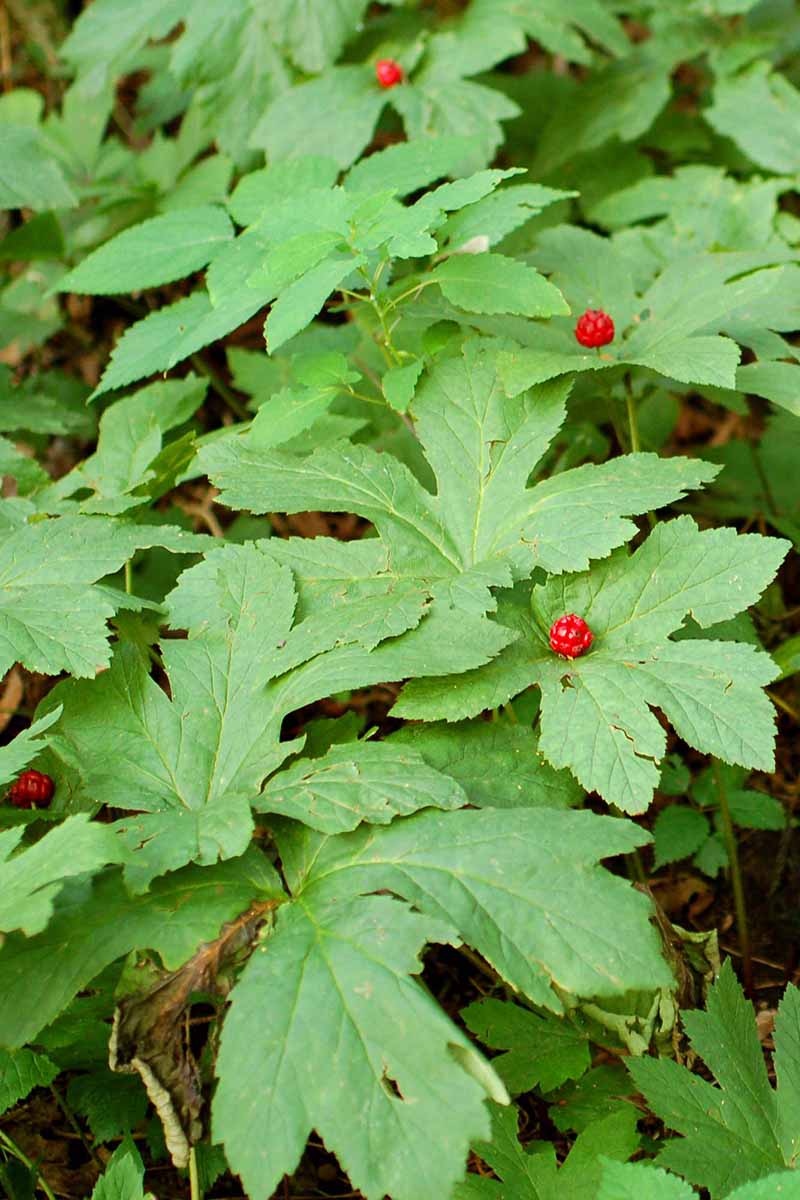
It’s such a popular medicinal herb that it’s on the brink of extinction in its native habitat. Help the poor species out and plant some in your own space.
Hardy in Zones 3 to 8, the foliage alone is lovely, but the pretty red berries add a pop of color to those darker areas.
Learn more about goldenseal and how to add it to your garden in our guide.
13. Lemon Balm
Every time I brush up against the foliage of lemon balm (Melissa officinalis) in my garden, it’s like an injection of summertime straight into my brain.
But even though the scent is what I imagine sunshine smells like, the herb itself doesn’t want that much exposure.
You can grow this mint relative in Zones 3 to 12, so pretty much anyone in North America can enjoy the summer scent.
Burpee has both live plants and packets of 700 seeds available.
You can find cultivation instructions in our growing guide and learn how to make lemon balm tea here.
14. Miner’s Lettuce
Miner’s lettuce (Claytonia perfoliata) is often dismissed as a weed and ignored as an herb garden option, and that’s such a shame, because it rocks.
Some “weeds” have a merely tolerable flavor – certainly not something that you’d cultivate and build recipes around. But not miner’s lettuce.
It’s worth intentionally growing like you would basil or spinach.
The leaves have a thick, crisp texture that crunches pleasantly between the teeth. The leaves and flowers taste like bean sprouts and spinach had a marvelous baby.
Beyond the flavor, it’s also an easy herb to grow. It’s super cold hardy and you’ll find it growing up through snow and ice. In fact, you can grow it all winter long in Zones 6 to 10.

While it isn’t the showiest plant on the market, it will make a pretty ground cover addition to the shadier spots of your yard.
It will even self-seed and politely spread around without becoming invasive.
Amazon carries packages of 5,000 or 10,000 seeds from Outsidepride, which should be just enough to get you through a few weeks if you eat as much winter purslane as I do.
15. Mint
Look at any roundup of shade-loving herbs, and mint (Mentha spp.) will undoubtedly top the list.
But it’s actually not “made in the shade.” Mint prefers full sun without any intense heat, but it will grow perfectly well in dark areas.
In the shade, it will be leggy and it might not flower regularly. But if you’re just after the leaves, it’s a workable option for Zones 3 to 9.
A 25-milligram packet of heirloom seeds from Botanical Interests can get you started.
Learn more about how to grow mint here. Interested in different types of mint? Our guides have you covered.
16. Mitsuba
Mitsuba (Cryptotaenia japonica) is the ultimate versatile herb. It will grow equally well in sun or shade.
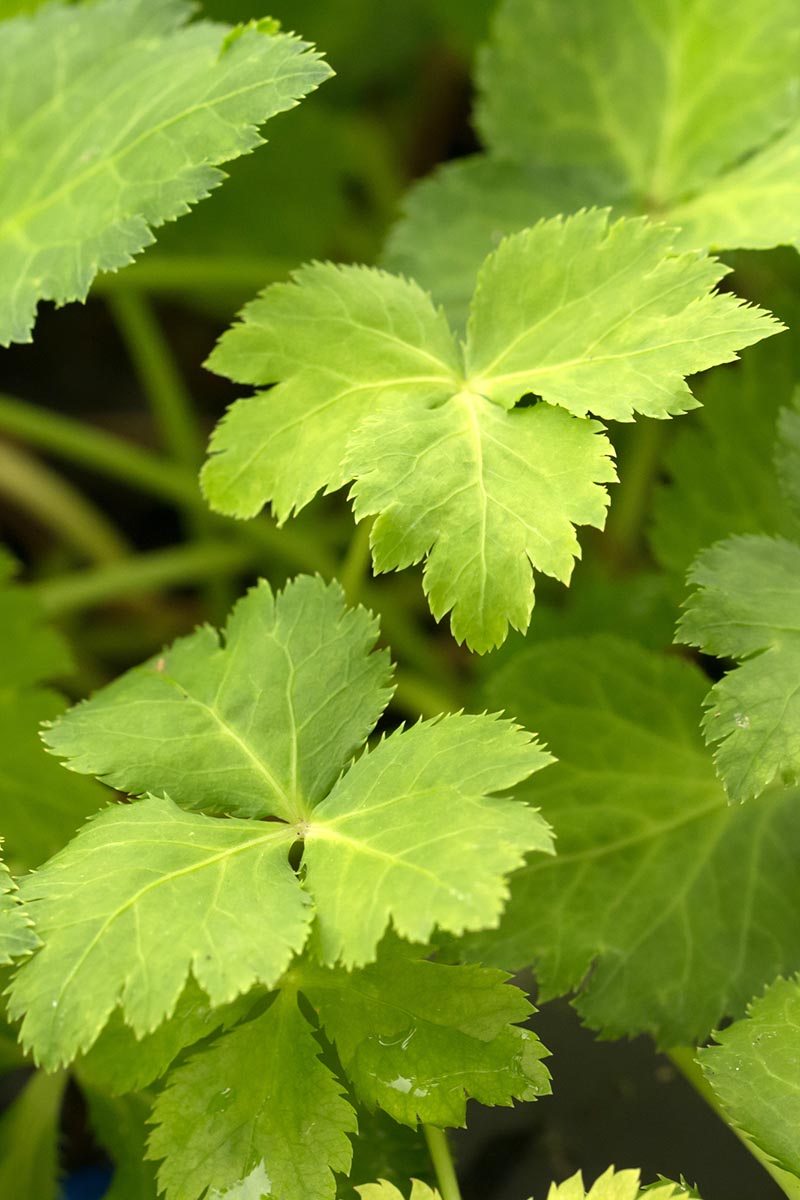
It can also handle a range of soils and can be used as an ornamental, herb, and a veggie. Plus, it’s resistant to pests and diseases and grows quickly.
I genuinely don’t understand why you can’t find it in every single garden in Zones 4 to 9. It should be as ubiquitous as spinach!
Want to learn more about mitsuba? Have a read of our growing guide.
17. Mizuna
If you like herbs with a peppery bite, snag some mizuna seeds.
While mizuna (Brassica rapa var. nipposinica) grows best with about four hours of light a day, particularly morning light, it won’t hate a spot in darker areas in Zones 3 to 10.
Mizuna isn’t fazed by cold weather either, and it reliably pops up even when there’s still snow on the ground.
Run to High Mowing Seeds to buy seeds in a variety of packet sizes.
Or better yet, grab several packs. You’ll find yourself adding these greens to just about anything you can think of.
Want to learn more? Check out our guide to growing mizuna here.
18. Ramps
Ramps (Allium tricoccum) are kind of weird when it comes to sunlight. Well, not weird. But they’re spring ephemerals, which means they grow in the spring and die back in the summer.
Most people assume they need shade, but they actually do better in an area where they receive full sun during the early spring when most deciduous trees are bare.
Then, as the trees fill out and ramps mature, they need shade.
I know, it seems confusing.
Pick up seeds from Earthbeat Seeds in packets of 25, 100, 500, or 1,000.
If you want more detailed information about how to grow ramps, check out our article, which covers all the ins-and-outs of growing this fantastic allium.
19. Stinging Nettle
Full shade makes stinging nettle (Urtica dioica) grow a bit leggy, but it can still grow in a darker area.
I can’t count the number of times when I was hiking or camping in some remote region and I brushed up against some stinging nettle alongside a trail completely covered by trees.
It might grow better in partial sun, but especially in hotter areas, it’s not going to say “no” to something shadier.
It grows in Zones 4 to 10 and it can be cultivated as an annual in Zone 3.
If you don’t already have the stuff growing all over the place near you, pick up packages of 500 seeds from Earthbeat Seeds.
Our article about growing stinging nettles has more information.
20. Solomon’s Seal
Plants in the Polygonatum genus make a striking architectural statement in the garden, but they can also be eaten.
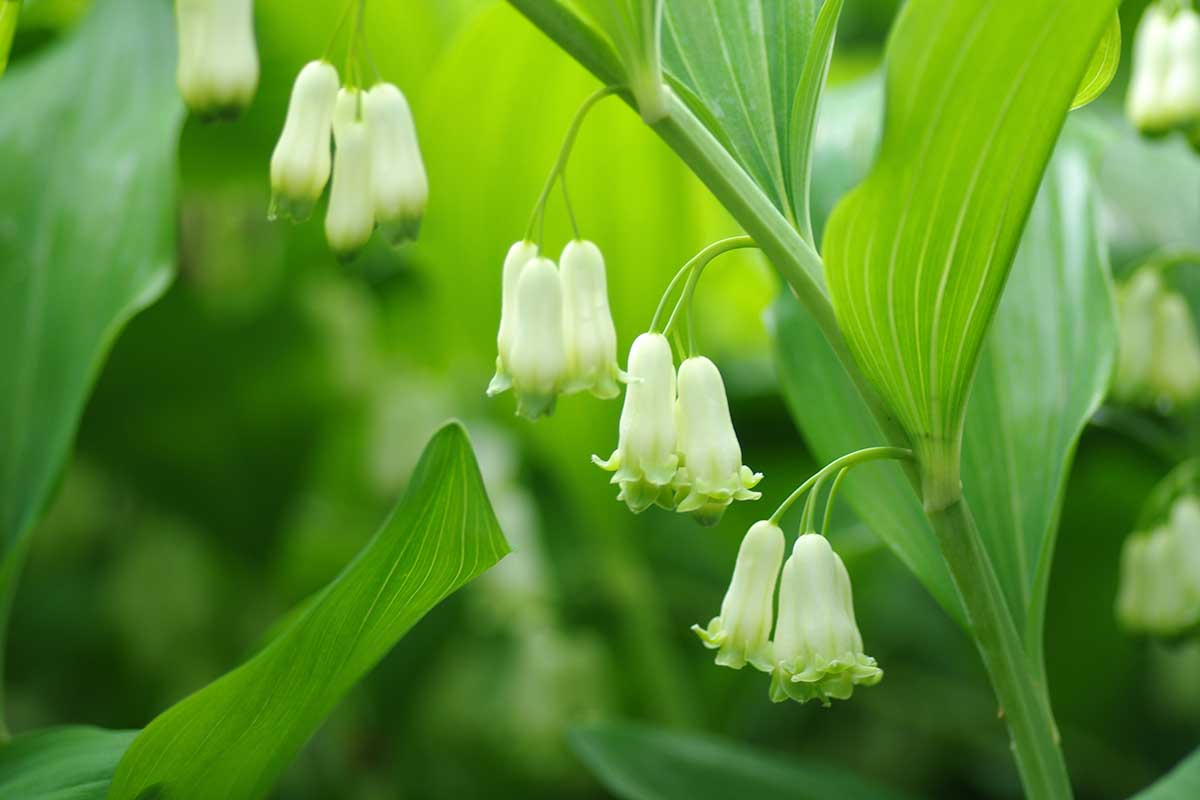
Drought-tolerant, deer resistant, and happy in the dark, these herbs are an underappreciated garden option. In Zones 3 to 9, they make an interesting addition.
21. Sweet Cicely
Don’t even think of sticking sweet cicely (Myrrhis odorata) where the sun shines.
Fern-leaf chervil, as it’s also known, looks a lot like chervil with lacy foliage and white umbels of blossoms. But unlike chervil, it likes to hang out in dappled light with moist soil.
It self-seeds readily in Zones 3 to 8 but it doesn’t become invasive, rewarding you with lots of licorice-scented leaves.
You can find packets of 20 seeds available from Earthbeat Seeds.
22. Sweet Woodruff
Wonderful sweet woodruff (Galium odoratum), also known as sweet-scented bedstraw, creates a carpet of delicate white flowers even in shady areas.
It’s a self-seeding perennial that makes a marvelous tea.

Grow it in Zones 3 to 8 as a potted herb, ground cover, or in a cluster with other low-growing plants. Run to Amazon to nab seeds.
23. Trillium
Trilliums (Trillium spp.) grow wild across the US in the understory of forests in Zones 4 to 9.
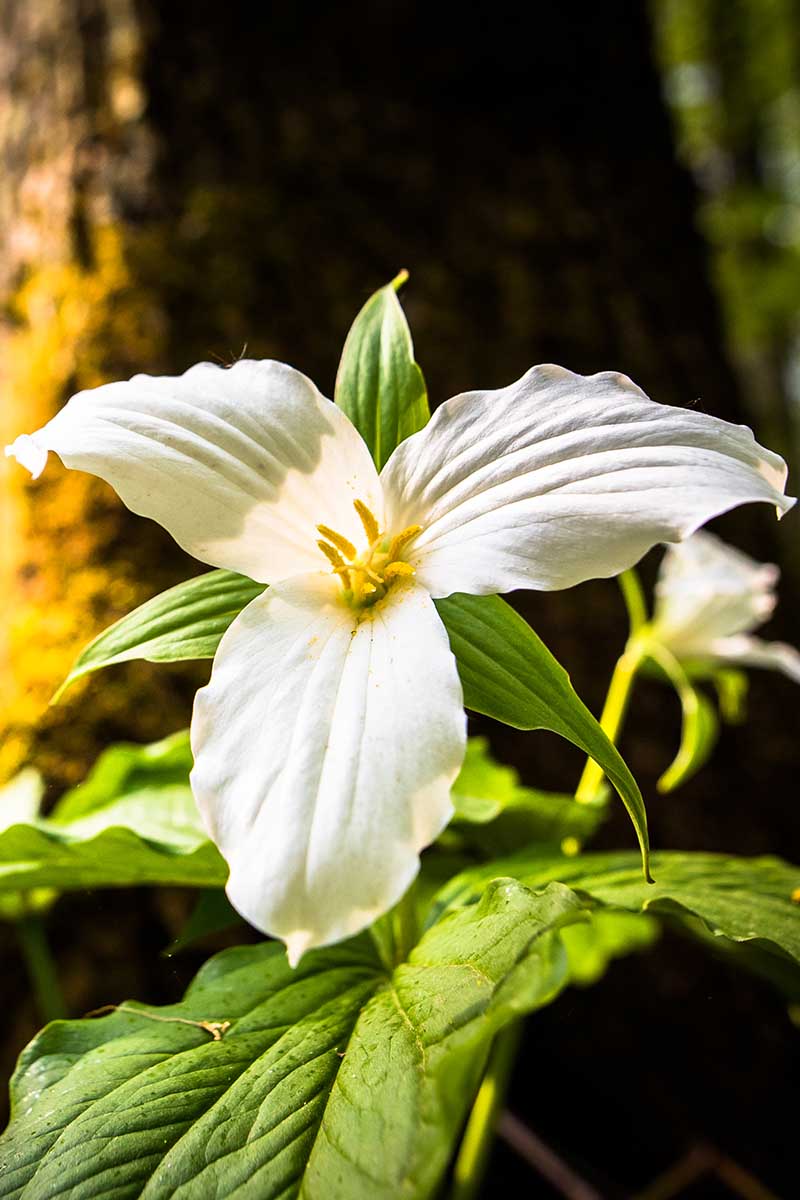
Most people use trilliums to create a colorful ground cover in challenging garden areas, but you can also eat them.
They’re a marvelous spring ephemeral and a native option that attracts beneficial critters.
You can learn all about trilliums in our growing guide.
24. Violets and Pansies
Violets are a mainstay in cool, moist, shady areas. However, not all violets are equally happy out of the spotlight.
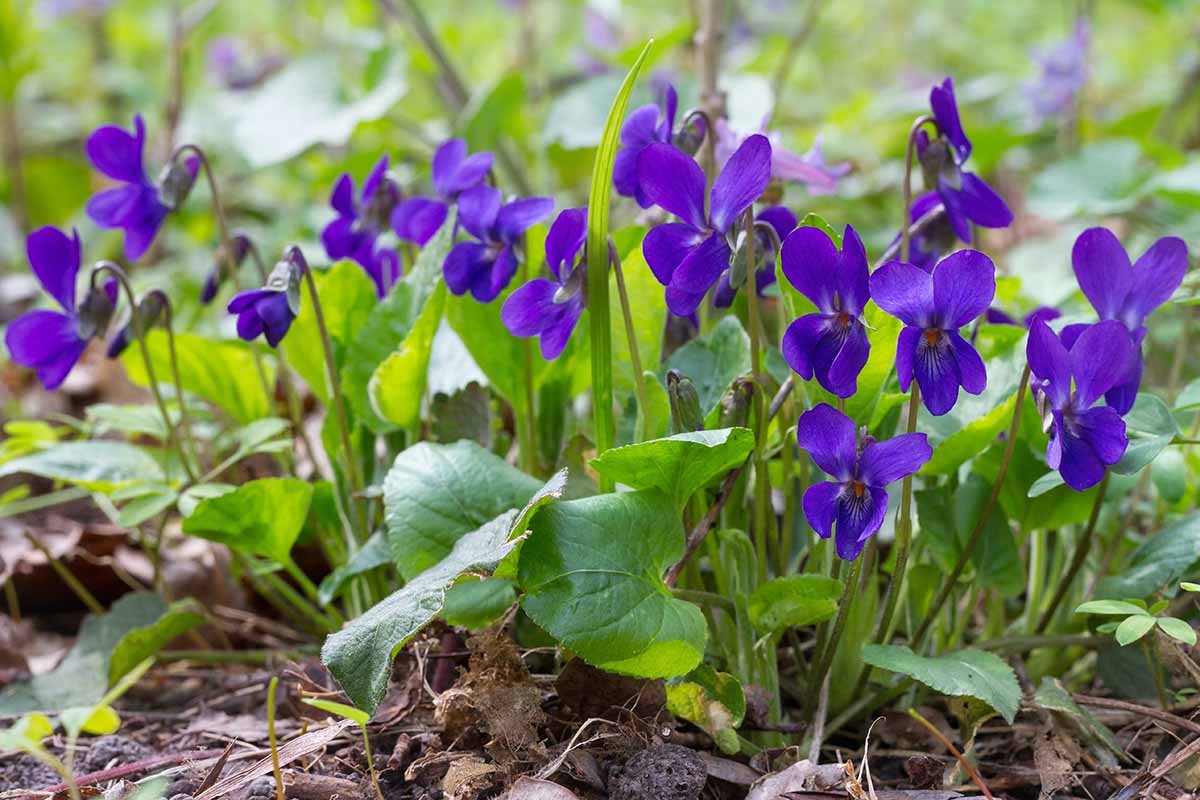
Dog violets (Viola riviniana), common blue violets (V. sororia), stream violets (V. glabella), evergreen violets (V. sempervirens), and sweet violets (V. odorata) all enjoy partial to full shade.
These cool-weather mainstays are happy in Zones 3 to 9.
Johnny jump-ups (V. tricolor) and mountain pansies (V. lutea) need full sun.
You can find seeds for a wide range of different cultivars available from Eden Brothers.
Learn more about violets in our comprehensive guides.
25. Wasabi
Wasabi (Eutrema japonicum) has a reputation as one of the most difficult plants to grow, but don’t let that daunt you.
If you live somewhere cool in Zones 8 to 10, try growing it and see what you can achieve.

Even if your plants never develop a massive rhizome, the leaves and flowers are delectable.
And it’s hard to find a plant that is happier in the dark than this one. It’s the vampire of the herb world.
This plant isn’t that difficult to keep alive if you provide consistent water and good drainage.
Developing the flavorful rhizome is what’s hard. When I’m struggling, I just put the leaves in a salad, sandwich, or soup and fry up the flowers, and all my woes are washed away.
Learn more about planting and growing wasabi here.
26. Wild Ginger
Wild gingers (Asarum canadense, A. caudatum, and A. marmoratum) are gorgeous ground covers with heart-shaped leaves and small purple or white flowers.
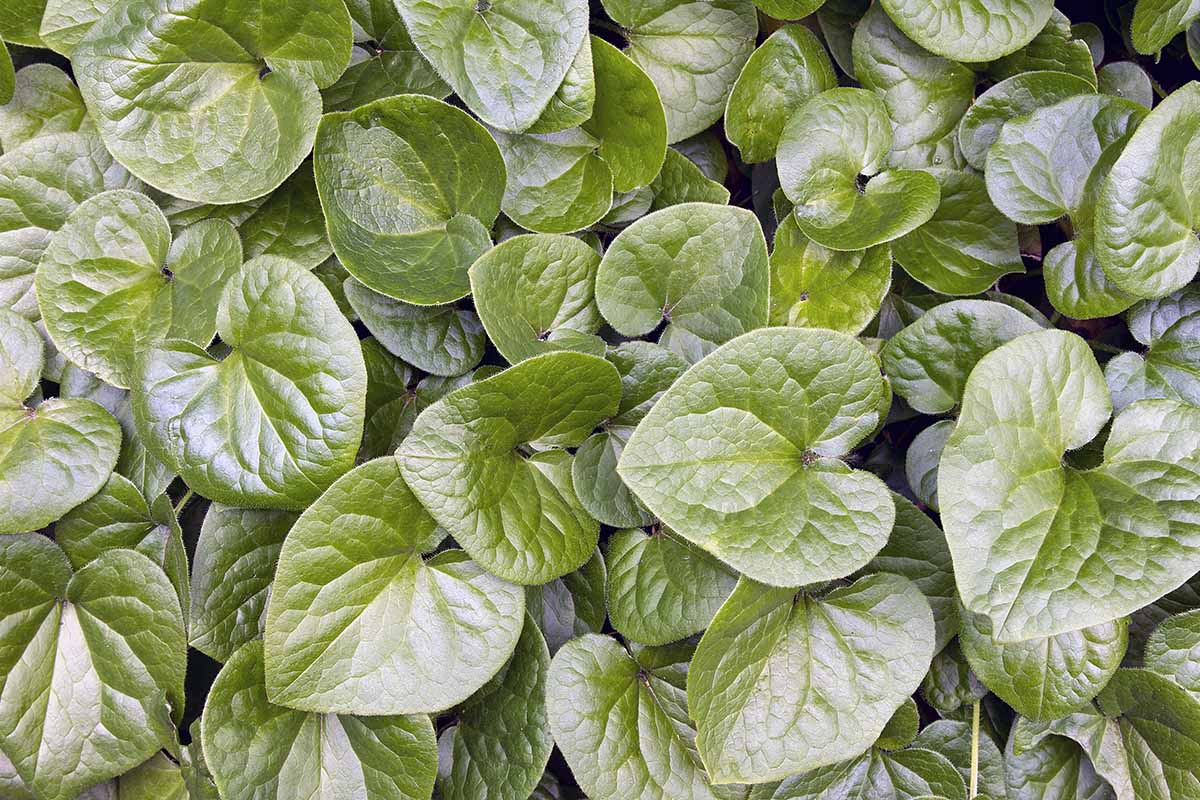
They’re nearly evergreen and thrive in deep, dark shade in Zones 4 to 8.
Totally edible, these plants have a mild ginger-like flavor, with the most pungent concentration in the roots. But they lack the zing that true ginger has.
27. Wintergreen
The colorful red berries on American wintergreen (Gaultheria procumbens) brighten up those dark regions.
Growing in Zones 3 to 7, these are technically shrubs, but we use the minty leaves as herbs. This is another North American native option that is excellent in the garden.
Can’t wait to start munching on all that goodness? Burpee carries live plants.
Herbs are Made in the Shade
A lack of light doesn’t condemn you to a life without delicious, medicinal, or otherwise useful herbs grown at home.
Go ahead and enjoy those towering trees and flowering archways. They can soak up all the sun they want, because these herbs are perfectly fine in the dark.

Which species do you plan to grow in your garden? How do you intend to use up the harvest? Share your ideas in the comments.
Then, if you’re ready to see the light, here are some options for growing herbs in full exposure spots:
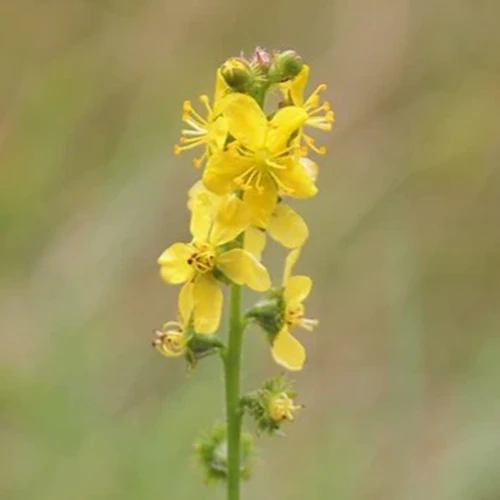
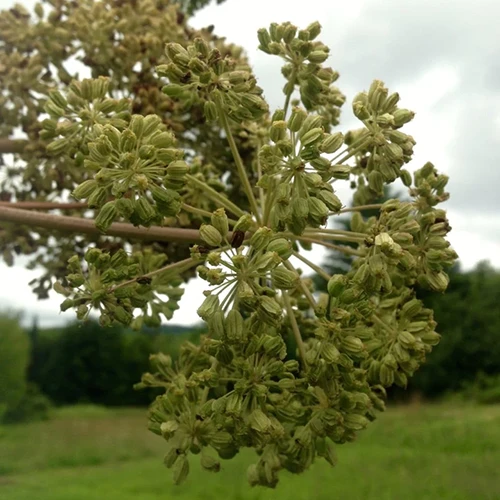



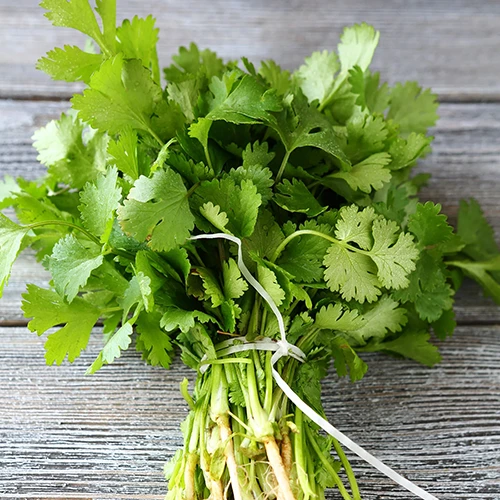
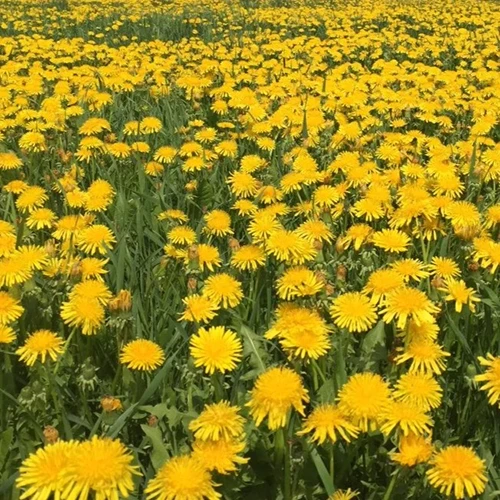
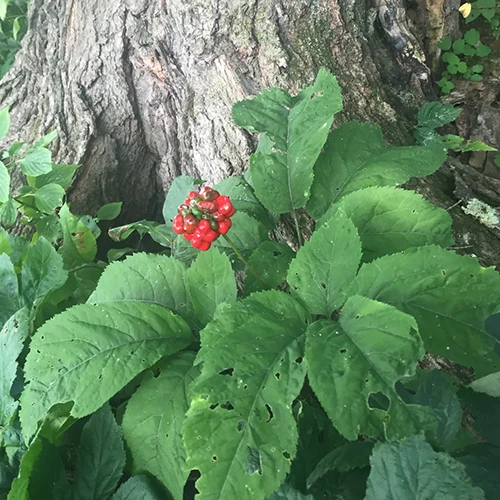
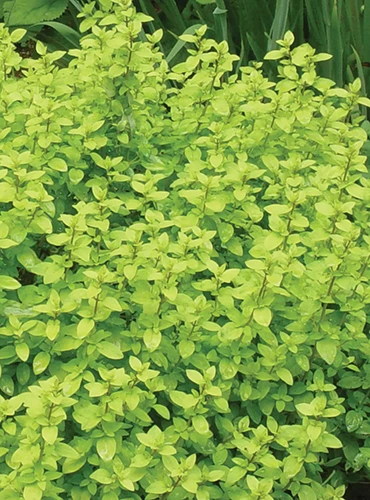
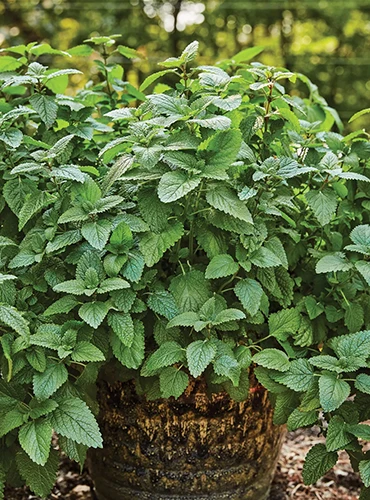
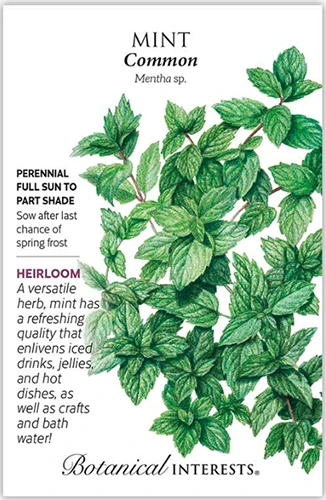

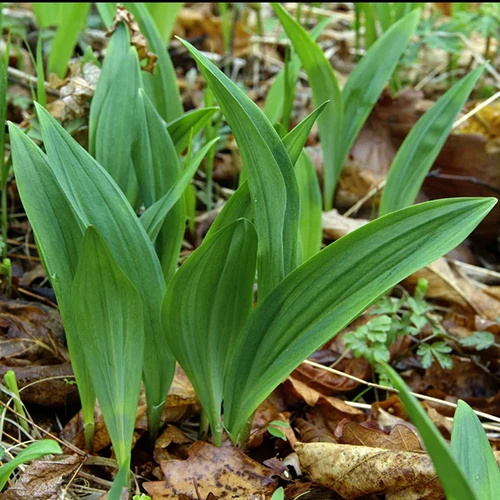
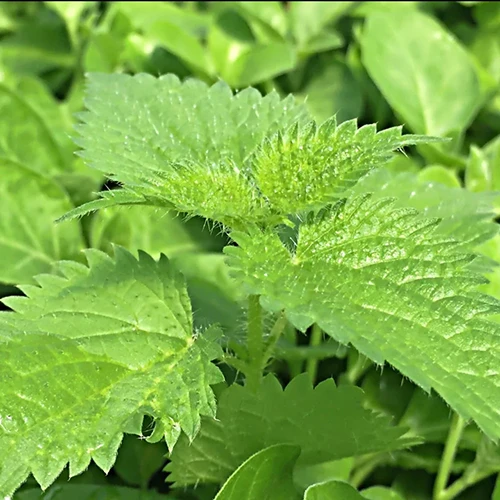
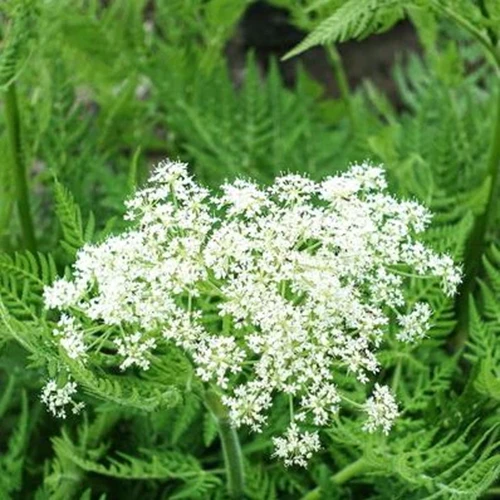

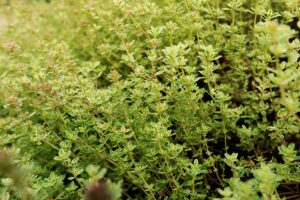
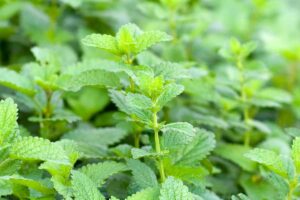

I love this site and learning about all herbs!! Thank you
Hi Gloria, thank you so much for the kind words! Happy gardening!